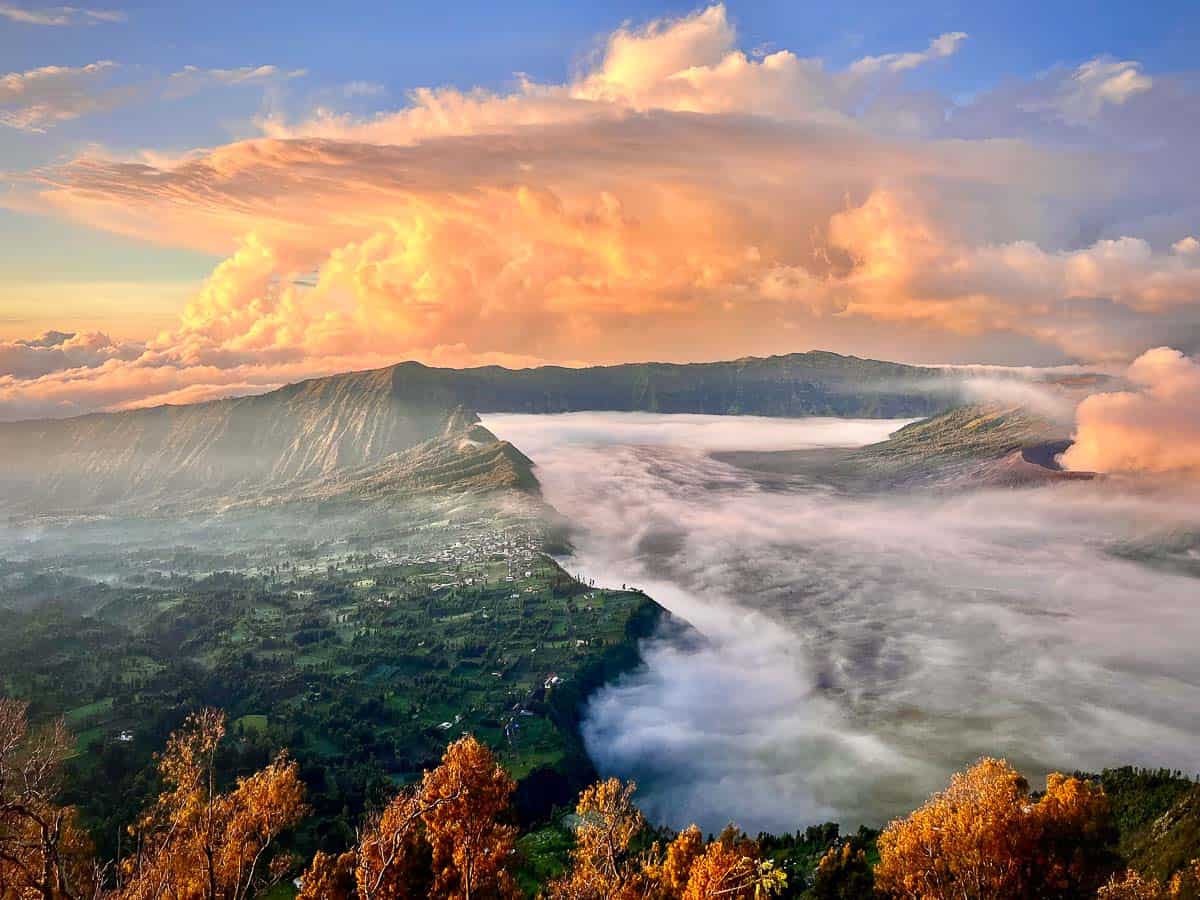25 Famous Landmarks In Southeast Asia to add to Your Bucket List

Wondering what are the most famous Southeast Asia landmarks to add to your next trip?
Southeast Asia is a spectacularly beautiful and culturally captivating region, comprising 11 countries from Indochina to Australia. With its pristine coastlines, extraordinary wildlife, ancient monuments, and unique cultural heritage scattered across the area – it’s no wonder this part of the world has become one of the most sought-after destinations for travelers around the globe!
Except for Cambodia and Laos, I have traveled to all the other countries in Southeast Asia extensively (yes, even Brunei and Timor-Leste!).
If you’re planning a journey here soon, check out my list below for what I consider to be some of the most famous landmarks from Southeast Asia that should be at the top of your bucket list! (Just to be fair, I’ve included at least one from each country.)
Easily Plan Your Trip with Some of My Favorite Resources Below!
► Cheapest Accommodation– I Always Use Booking.com
► Adventurous Tours– I Recommend Viator.com
► Car Rental– I Always Use DiscoverCars.com
25 Famous Southeast Asia Landmarks (Sorted by Country)
- Brunei: Omar Ali Saifuddien Mosque
- Cambodia: Angkor Wat, Killing Fields & Genocide Museum
- Indonesia: Borobodur, Prambanan, Mount Bromo, Komodo National Park, Tumpak Sewu Waterfall, Raja Ampat, Mount Rinjani, Kelimutu Volcano
- Laos: Kuang Si Waterfall
- Malaysia: Petronas Towers, Batu Caves
- Myanmar: Bagan, Shwedagon Pagoda
- Philippines: Palawan Island (Puerto Princessa & El Nido)
- Singapore: Marina Bay Sands (Gardens by the Bay)
- Thailand: Grand Palace, White Temple, Railay Beach
- Timor-Leste: Cristo Rei
- Vietnam: Han Son Doong, Ha Giang Loop, Ha Long Bay
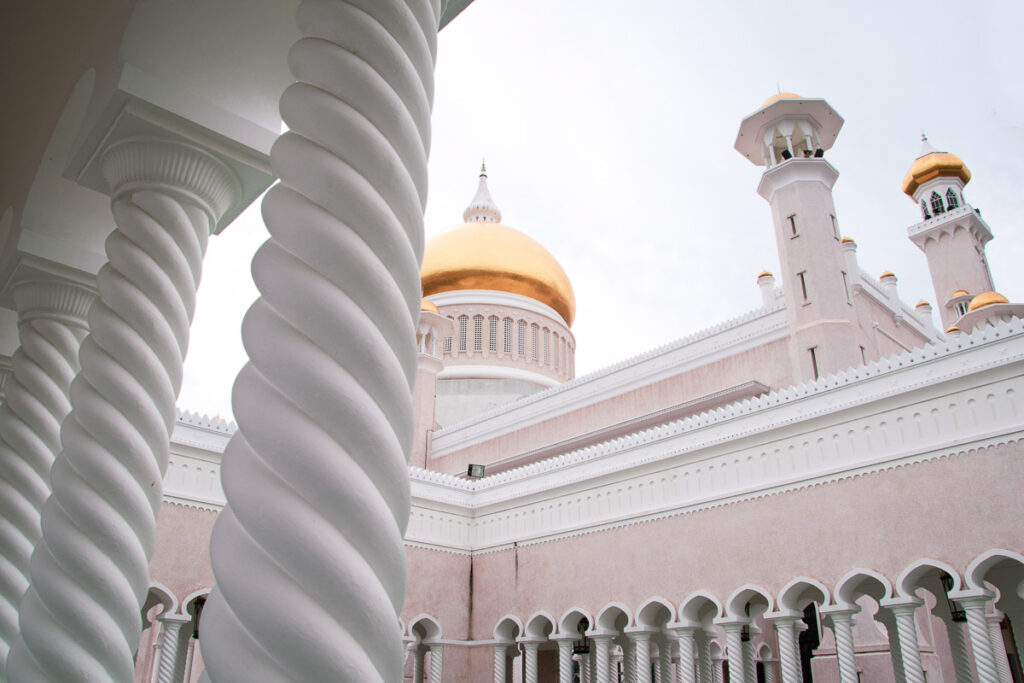
1. Omar Ali Saifuddien Mosque, Brunei
The Omar Ali Saifuddien Mosque, located in the heart of Bandar Seri Begawan, Brunei, is an architectural masterpiece that combines modern and traditional Islamic design. This mosque is not only a place of worship but also a symbol of Brunei’s rich cultural heritage.
Today, this Islamic mosque remains an important religious site where Muslims come to pray and observe the holy month of Ramadan. Non-Muslims are welcome to enter the mosque outside of prayer times and must dress modestly.
Fun Fact: Did you know you cannot consume food or drink in public during Ramadan in Brunei? I didn’t either and just accepted the judgy stares until someone told me.
The mosque doubles as a popular tourist attraction, offering guided tours to those who wish to marvel at its golden dome and minarets, which are visible from almost every corner of the city. The interior is equally impressive with intricate marble carvings, crystal chandeliers, and a beautiful prayer hall.
The best time to visit is at dusk when the mosque is illuminated with thousands of tiny lights and offers a quintessential city view.
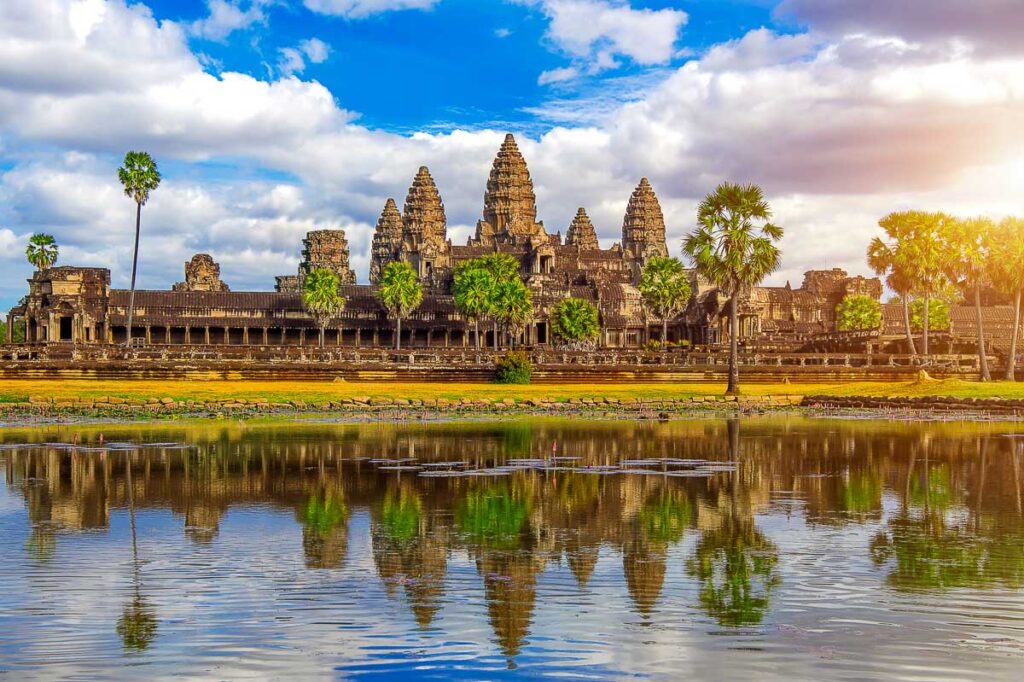
2. Angkor Wat, Cambodia
Situated in Siem Reap, Cambodia, Angkor Wat is one of the largest religious monuments ever built and a glorious reminder of its Khmer Empire.
Built in the early 12th century by King Suryavarman II, Angkor Wat is the largest religious site in the world, covering 402 acres.
Today, Angkor Wat is a popular tourist attraction and a UNESCO World Heritage Site. Tourists can wander around the grounds, admire its intricate bas-reliefs, and gain insight into Cambodia’s long-forgotten ancient empire.
To Visit: You can stroll around yourself or join this Angkor Wat tour to climb around the complex and get the sunrise experience.
3. Tuol Sleng Genocide Museum, Cambodia
The Killing Fields and Genocide Museum in Cambodia are powerful reminders of the country’s dark history under the Khmer Rouge regime. This somber landmark inside Phnom Penh offers visitors a sobering look at the atrocities committed during this period.
The Khmer Rouge was a communist regime that ruled Cambodia from 1975 to 1979. During this time, an estimated 1.5 – 3 million Cambodians were killed or died from starvation and disease as part of the regime’s radical social engineering policies.
The Tuol Sleng Genocide Museum was once a high school but was converted into a prison camp by the Khmer Rouge. Visitors can see torture chambers, cramped cells, and photographs of prisoners taken before their execution.
While visiting the Genocide Museum may be emotionally challenging, it offers important lessons about humanity and serves as a tribute to those who suffered under the Khmer Rouge regime. It’s an essential destination to learn more about from a guide for anyone seeking to understand Cambodia’s complex history and a powerful reminder of how far the nation has come.
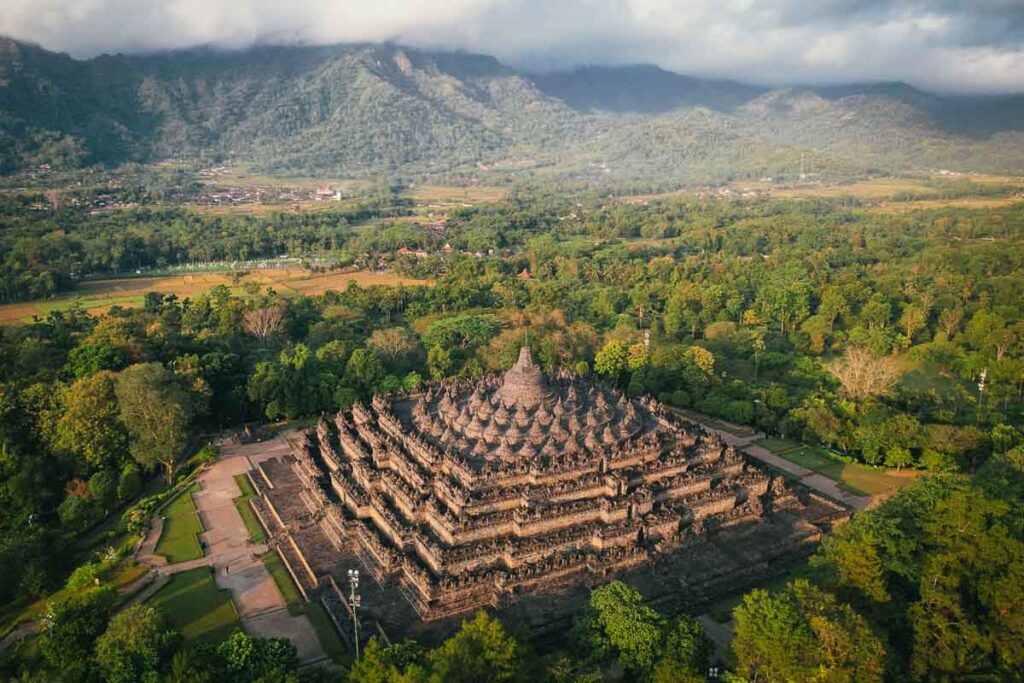
4. Borobudur Temple, Indonesia
Hidden in the lush jungles of central Java, Indonesia, lies one of the world’s most impressive architectural achievements: Borobudur, the largest Buddhist temple in the world.
Borobudur served as a pilgrimage site for Buddhists from across Asia until it was abandoned. The temple was rediscovered by Europeans in the 19th century and underwent extensive restoration efforts in the following decades.
Today, Borobudur is a UNESCO World Heritage Site and a popular tourist attraction that attracts more than a million visitors annually. The temple features nine levels, each representing a stage of enlightenment in Buddhist philosophy.
To visit Borobudur, you can take a bus or hire a car from Yogyakarta. Most tourists come to Borobudur for this iconic sunrise tour. However, since the pandemic, you can no longer climb up the structure.
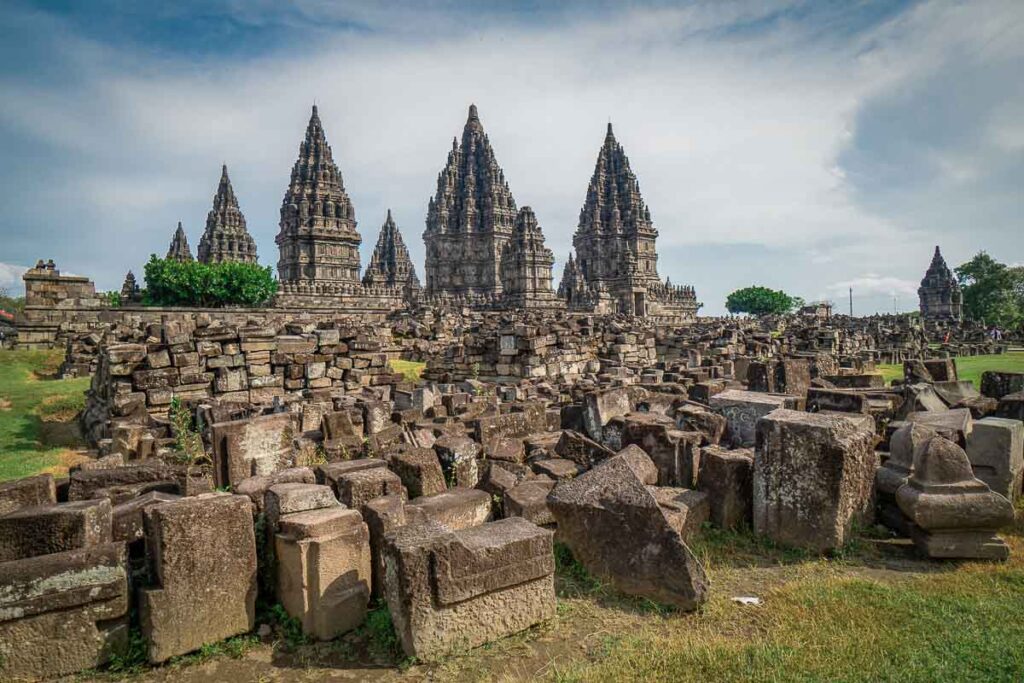
5. Prambanan Temple, Indonesia
Prambanan in Java, Indonesia, is an ancient Hindu temple complex renowned for its impressive architecture and intricate carvings. The complex features three main temples dedicated to the Hindu deities Shiva, Brahma, and Vishnu, all adorned with ornate sculptures depicting scenes from the Ramayana epic.
The temple itself dates back to the 9th century and is now a UNESCO World Heritage Site. Stroll around the complex on foot, take part in guided tours, and join a cultural performance that takes place just outside the main entrance a few times a week after sunset.
Budgeting Tip! Tour Prambanan and Borobudur together as discounted entrance fees are available for combining the two Yogyakarta attractions.
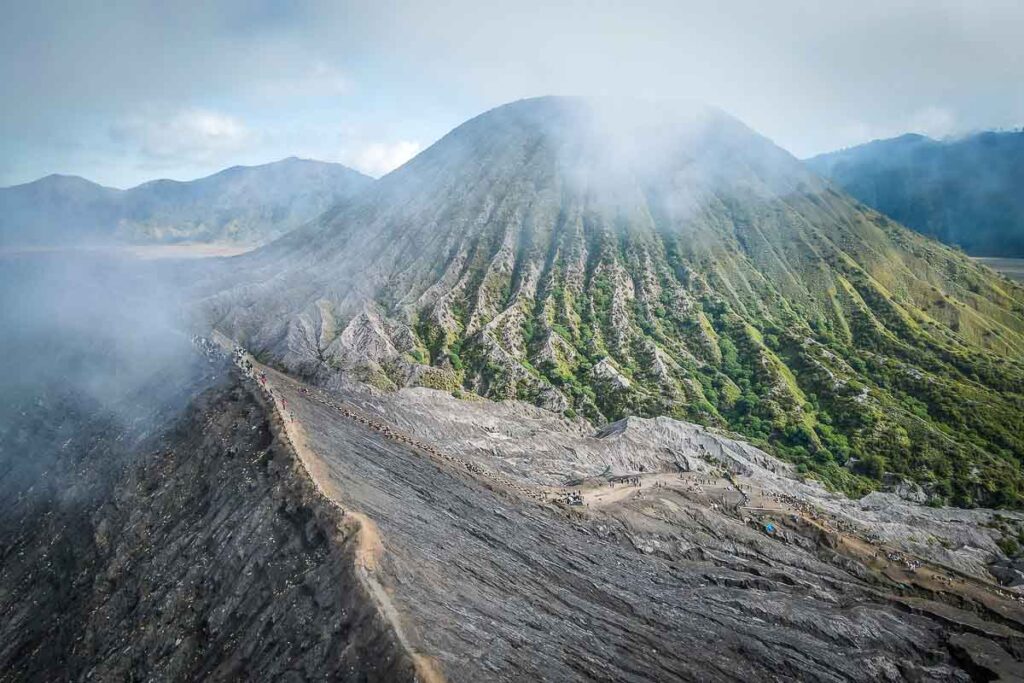
6. Mount Bromo, Indonesia
Rising majestically from the East Java landscape, Mount Bromo is a must-see destination for any adventurous traveler. Located within the Bromo Tengger Semeru National Park, this active volcano stands more than 2,329 meters above sea level and has been erupting for centuries.
Surrounded by a landscape of sand and ash, the craters of Mount Bromo is one of Indonesia’s most popular tourist attractions. Ride through the desolate terrain on a 4×4 jeep to witness the epic sunrise over its smoldering crater, then take a morning hike up to the crater.
To visit Mount Bromo, most people either arrive at the foothills of Bromo the day before or leave with a tour from Malang in the wee hours of the morning. It’s also common to combine Mount Ijen like this one option. Most tours arrive early to see the epic sunrises and morning fog flowing into the crater.
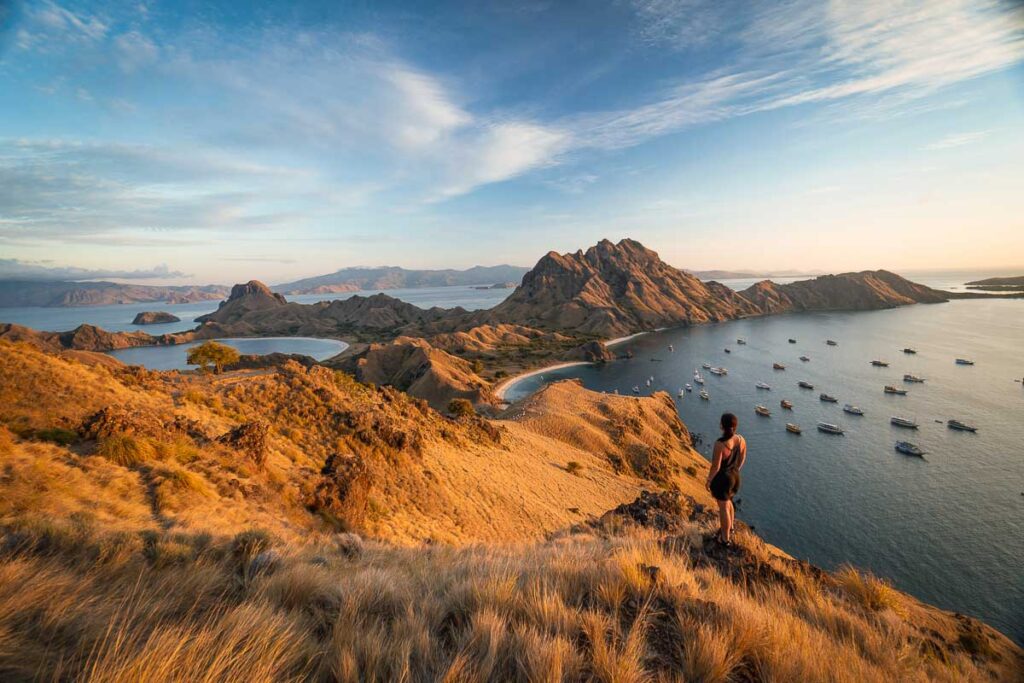
7. Komodo National Park, Indonesia
Did you know that the famous Komodo dragon, the world’s largest lizard species, can grow up to 10 feet long and weigh over 300 pounds? You can witness these fantastic creatures up close by visiting Komodo National Park in Indonesia.
Located in the Lesser Sunda Islands, Komodo National Park is a UNESCO World Heritage Site established to protect the endangered Komodo dragon. The park encompasses three main islands: Komodo, Rinca, and Padar, as well as numerous smaller islands.
Boat around these islands and encounter not only these majestic dragons but also insane island landscapes, like the tri-colored bays of Padar or pink beaches. Activities in the park include hiking, snorkeling, diving, and wildlife watching.
To visit Komodo National Park, fly into Labuan Bajo on Flores Island and take a 1-4 day boat ride to one of the park’s main islands (Check out this intense 4 day tour). You can also take a four-day boat from Lombok, making a few island and snorkeling stops on the way.
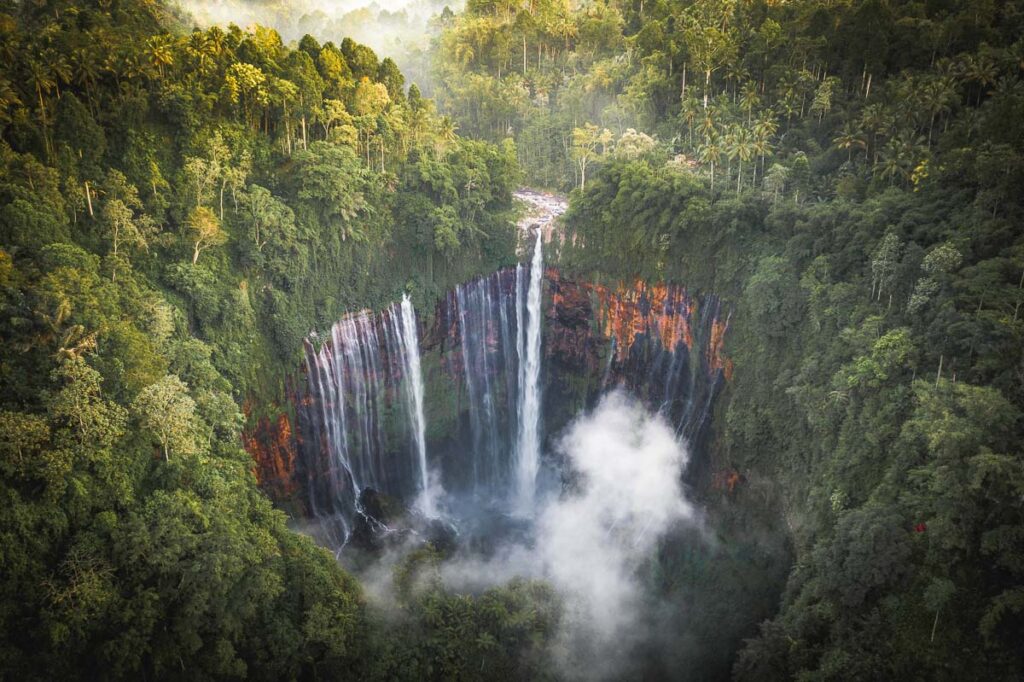
8. Tumpak Sewu Waterfall, Indonesia
Tukpak Sewu is truly the epitome of waterfalls. Even though I missed my chance of going there myself, I’m convinced this hidden gem collection of more than one hundred cascading falls standing in front of Merapi Volcano will forever stand unmatched in beauty and grandeur.
Falling in the East Java province of Indonesia, Tumpak Sewu is one of the most beautiful waterfalls in Southeast Asia, if not the world. Surrounded by tropical vegetation, this cascade consists of multiple tiers, with the highest reaching 120 meters.
Get to Tukpak Sewu by motorbike or guided tour like this one. Although the viewing platform is a short walk away, climbing down the slippery rocks is possible for a closer view. Prepare to get very wet and put yourself in a bit of danger.
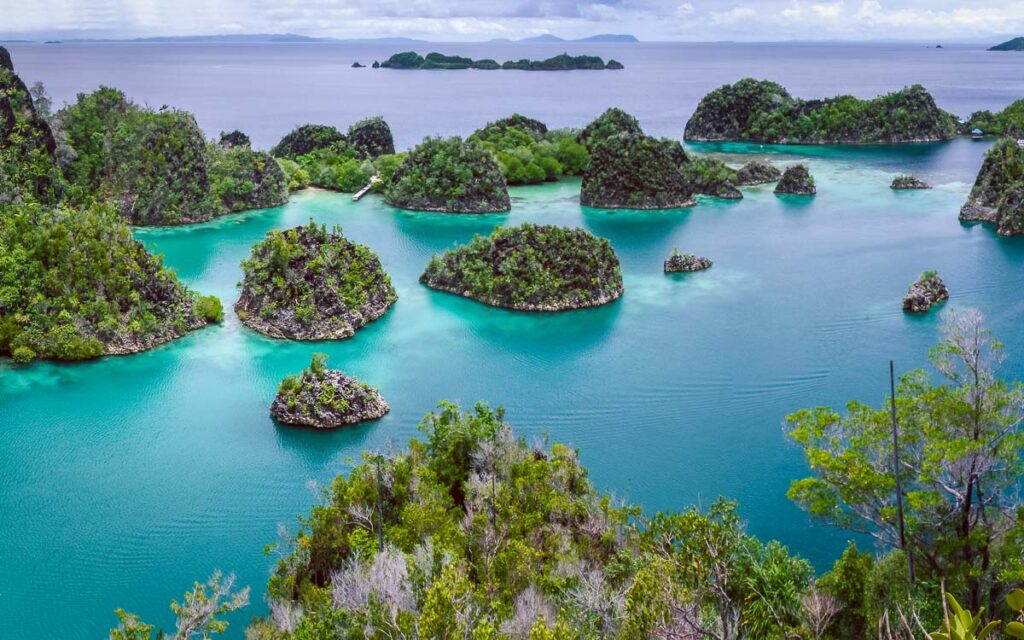
9. Raja Ampat, Indonesia
Covering an impressive 40,000 square kilometers, Raja Ampat consists of four main islands and numerous other islands, cays and shoals. This island group is part of the greater island of West Papua.
Some of the world’s most beautiful coral reefs can be found here. Home to over 1,000 species of fish and 500 species of coral, this archipelago is a haven for divers and snorkelers seeking an underwater paradise.
The area is known for its crystal-clear waters and diverse range of larger sea creatures, like manta rays and sharks. Scattered among the turquoise waters are hidden lagoons, bays, and white sandy beaches where you can relax between dives.
The best way to explore Raja Ampat is to somehow have access to a boat or join a liveaboard tour like this one that takes you across the different islands. Although it’s a bit of a journey to get here and majorly expensive, this famous Indonesian landmark is worth it.

10. Mount Rinjani, Lombok, Indonesia
Mount Rinjani is the second-highest volcano in Indonesia, standing at 3,726 meters above sea level. In recent eruptions, there’s even now a mini-volcano forming inside the crater lake!
Taking up nearly a quarter of the island of Lombok, its presence can even be seen over in East Bali. Aside from amazing views, this amazing Lombok attraction presents a challenging adventure for those who dare to climb it.
Hikers can embark on a multi-day trek up the mountain, passing through endless greenery and rocky terrain before reaching the summit. Even as an avid hiker, I warn that the climb is challenging.
Extremely sandy, the last hours before the summit, you slip down almost as far as you climb up. But it is oh so rewarding watching the views from the summit of the crater lake and even neighboring Bali on clear days. On different routes, you can hike into the crater lake, soak in the nearby hot springs, or check out some Lombok waterfalls.
To visit Mount Rinjani, fly into Lombok International Airport or take the fast ferry from Bali. Then you will have to take transport and stay overnight at Senaru or Sembalun village, which serve as starting points for treks up the mountain. You must hire a guide or join a tour group to hike this natural Southeast Asia landmark.
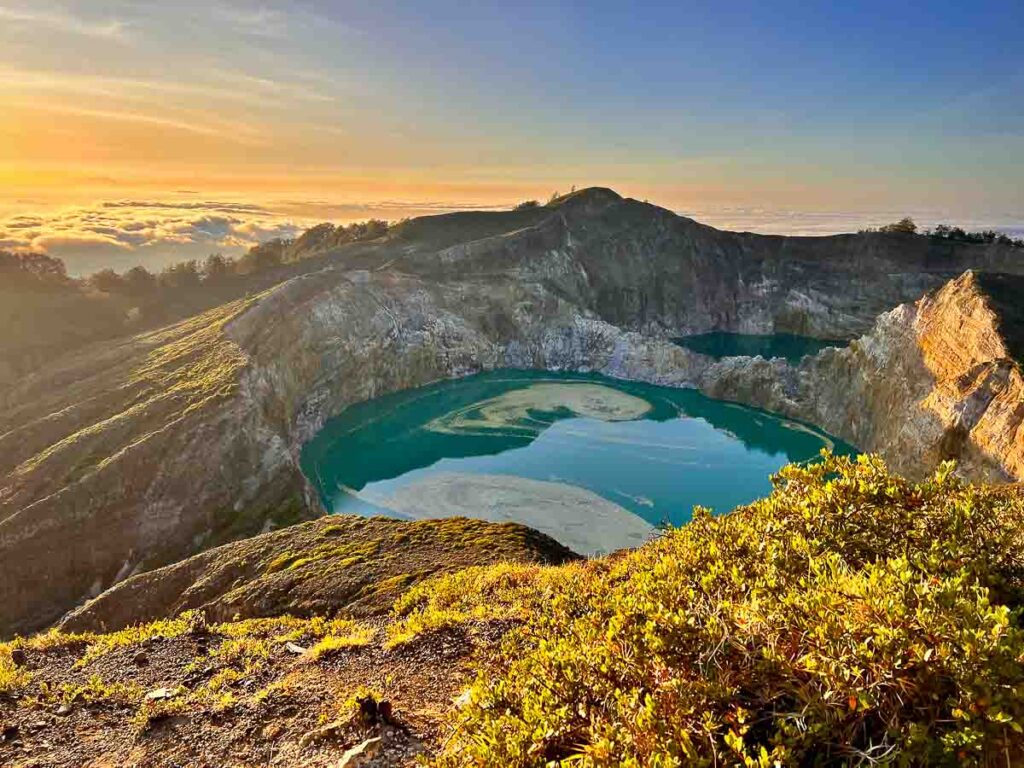
11. Kelimutu Volcano, Flores, Indonesia
Kelimutu National Park is home to a fascinating landmark – the Kelimutu volcano. In the middle of the island of Flores, east of Lombok, it boasts three colored lakes of incredible hues that change colors throughout the year.
The three crater lakes, known as ‘Tiwu Ata Bupu’, ‘Tiwu Nuwa Muri Koo Fai’ and ‘Tiwu Ata Polo’ each have their own distinct shades – from turquoise to navy blue and even a dark red. The colors of the lakes change depending on factors such as sunlight and volcanic activity.
According to local mythology, these different colors are said to be the souls of people who have passed away and now rest in the lake.
To visit Kelimutu Volcano, traverse across Flores overland or fly to Ende Airport. Then you will have to take a car or bus to Moni village, the starting point. You don’t need a guide for Kelimutu, as the hike from the parking lot is short and easy.
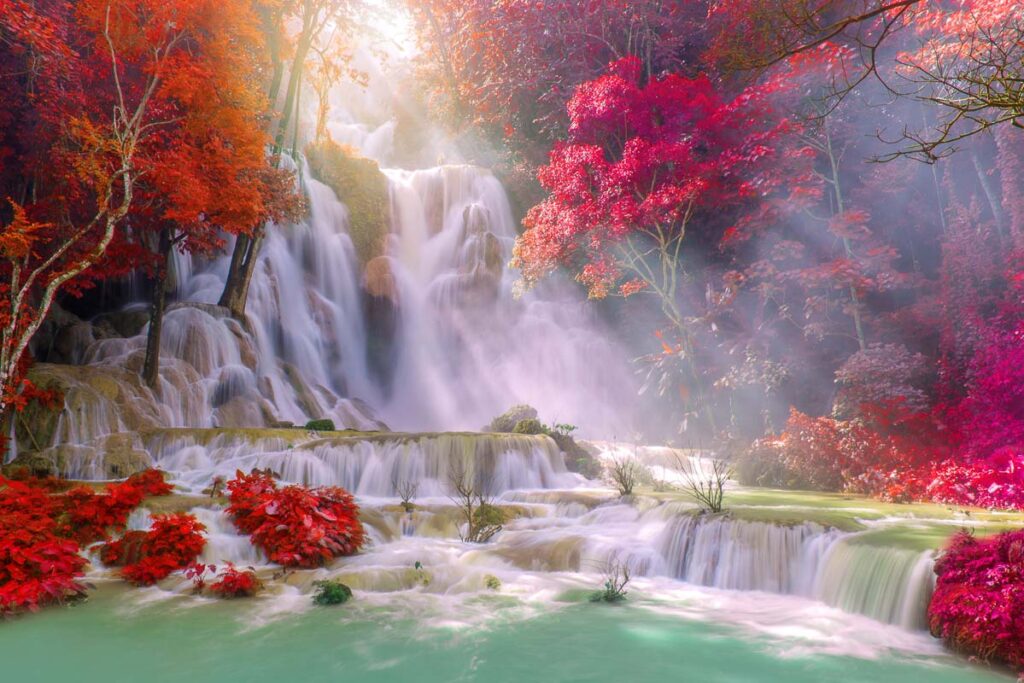
12. Kuang Si Waterfall, Laos
Nestled in the jungles of Laos, Kuang Si Waterfall, located only 31 kilometers outside of Luang Prabang, is one of the most visited attractions in Laos. The three-tier waterfall cascades into a turquoise-colored pool, forming multiple natural pools along its course.
Trek through lush forests and swim in the crystal-clear turquoise waters where you can cool off and relax. You can also check out some nearby trails and a bear sanctuary.
To visit Kuang Si Waterfall, access Kuang Si Waterfall via a tour or use public transportation to get there.
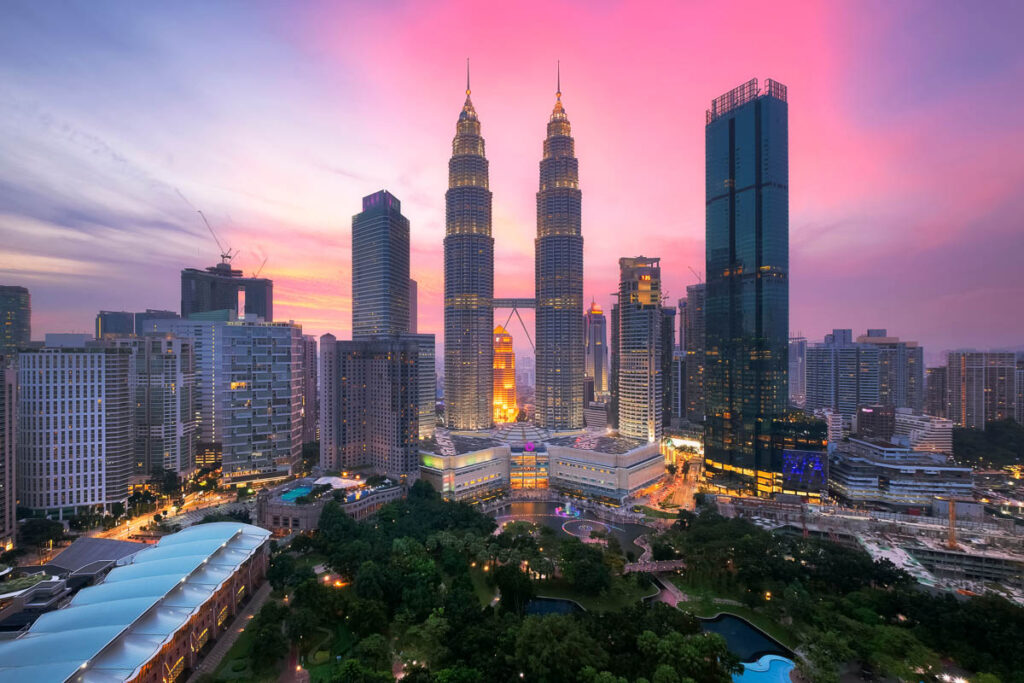
13. Petronas Towers, Malaysia
Located in the heart of Kuala Lumpur, the Petronas Towers were once the tallest buildings in the world. At a height of 1,483 ft (452 meters), the towers held this record from 1998 to 2004 before being surpassed by Taipei 101.
Enjoy amazing city views from the Skybridge, which connects the two towers on their 41st and 42nd floors. You can also take an elevator up to the observation deck on the 86th floor for even more stunning vistas.
If you want to visit Petronas Towers, you can purchase tickets online ahead of time or buy them on-site if available. It’s recommended that you arrive early to avoid long lines.
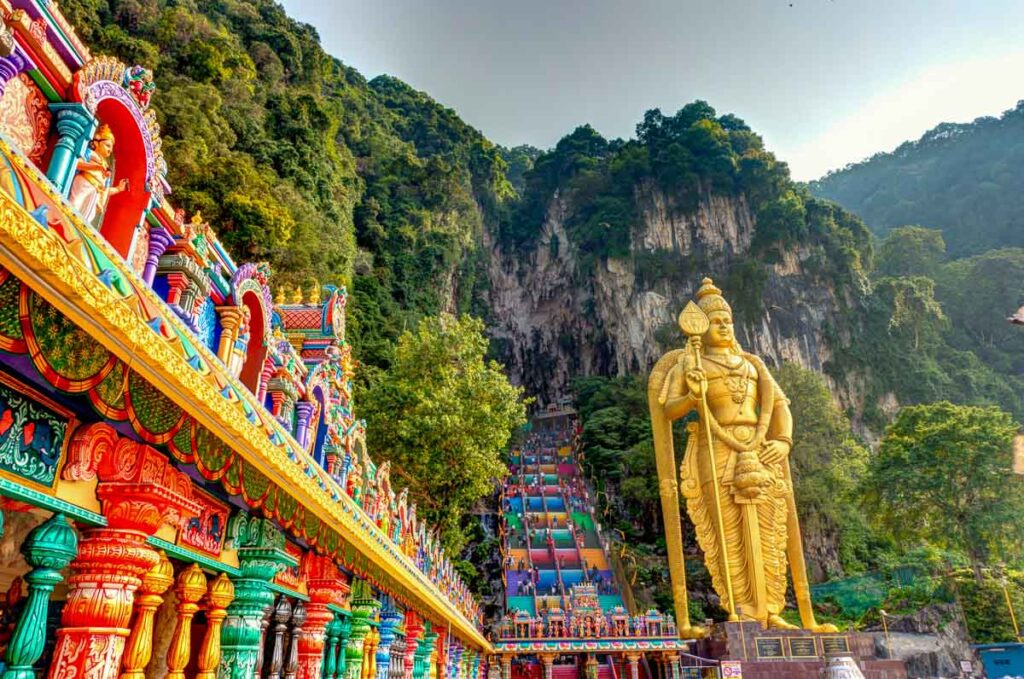
14. Batu Caves, Malaysia
The Batu Caves were shaped over 400 million years ago and have been important for religious pilgrimages since the late 1800s. Formed just outside of Kuala Lumpur, Batu Caves is one of the most popular Hindu shrines outside of India.
The main attraction of Batu Caves is the massive statue of Lord Murugan standing at the height of 140 feet. Take a flight of stairs leading up to the temple complex with three main caves – Cathedral Cave, Art Gallery Cave, and Museum Cave. Each cave has unique features, such as intricate carvings, colorful paintings, and statues depicting various deities.
If you’re looking for a shocking cultural festival, coincide your visit Thaipusam. Devotees carry offerings while climbing up 272 steps to reach the temple at the top. But not with their hands, more like hooked onto their skin.
To visit Batu Caves, you can take a train or bus from Kuala Lumpur, and the journey takes approximately 30 minutes. Combine your trip to Petronas Tower and Batu Caves with this tour.
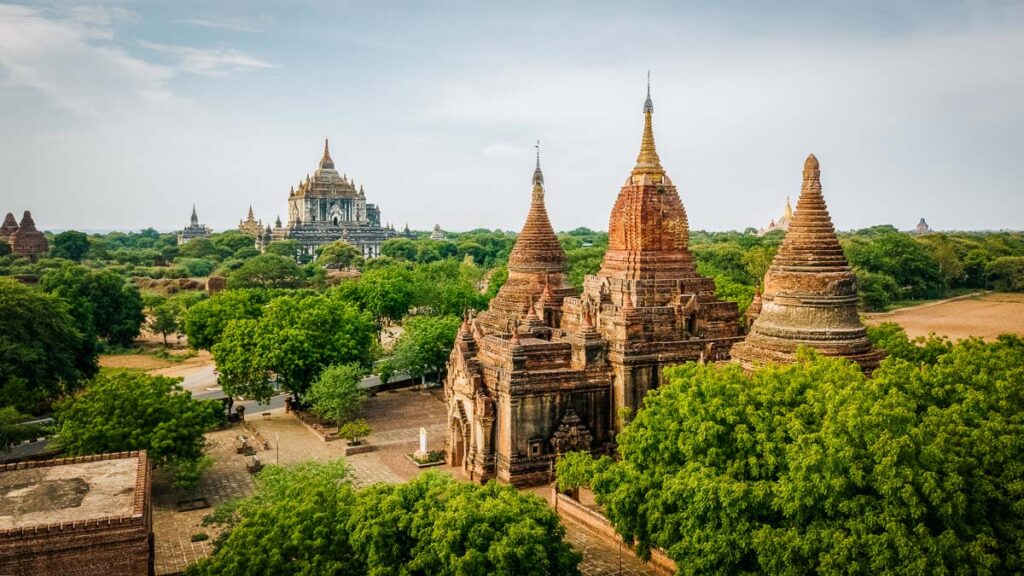
15. Bagan, Myanmar
Bagan, Myanmar, is an ancient city that boasts over 3,500 temples and pagodas. Once the capital of the Pagan Kingdom, it was a center for learning and religion. Many of these structures still stand today and offer visitors a glimpse into Myanmar’s rich past.
Rent a scooter or bicycle and ride around endless temples and pagodas. From Shwezigon Pagoda to Ananda Temple, you literally won’t be able to see them all. You can also take a hot air balloon ride over the city to get a sunrise bird’s eye view of this impressive landscape.
To visit Bagan, take a bus from nearby cities Yangon. Once there, you can rent a bike or scooter to ride around the temples at your own pace.
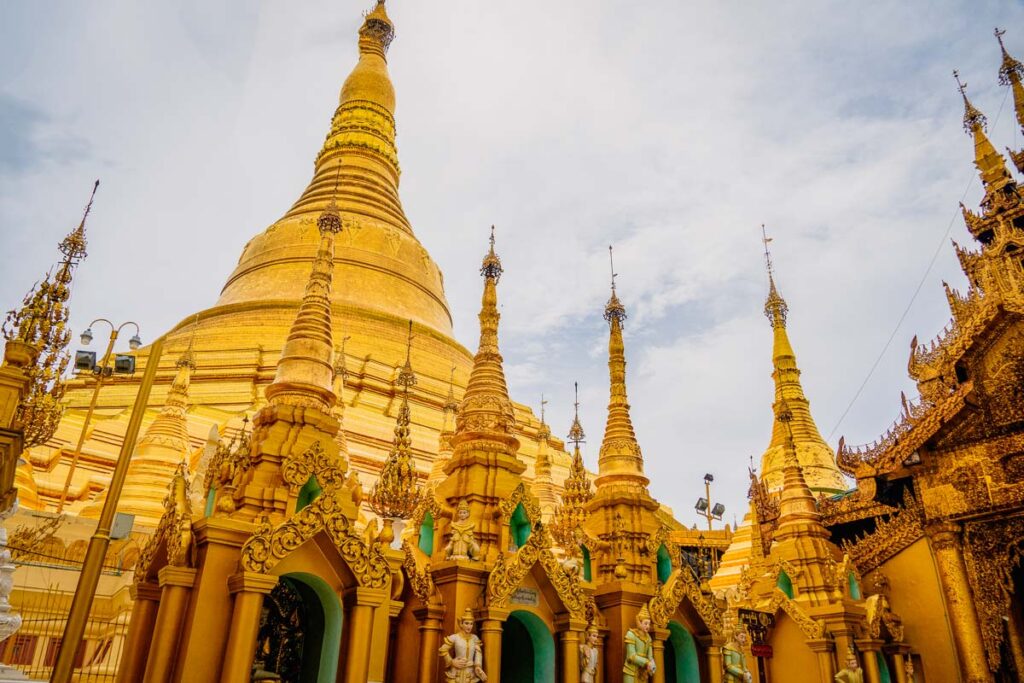
16. Shwedagon Pagoda, Myanmar
Marvel at the beauty of Myanmar’s most sacred Buddhist site when you visit Shwedagon Pagoda. Located in Yangon, this massive pagoda is not just any old temple – it stands 112 meters tall and is covered with 27 tons of pure gold! Its golden spire can be seen shimmering from miles away, making it one of Southeast Asia’s most famous landmarks.
The impressive pagoda was first built during the 6th century, although it has been renovated several times over the centuries. As you walk around the grounds, prepare to be dazzled by thousands of diamonds and gems that adorn different parts of the structure. Within the complex, you’ll also find dozens of shrines, stupas and bell-shaped monuments – each one depicting its own unique story.
To visit Shwedagon Pagoda, you can take a taxi or public transportation from anywhere in Yangon. Before your journey here, make sure to dress conservatively.
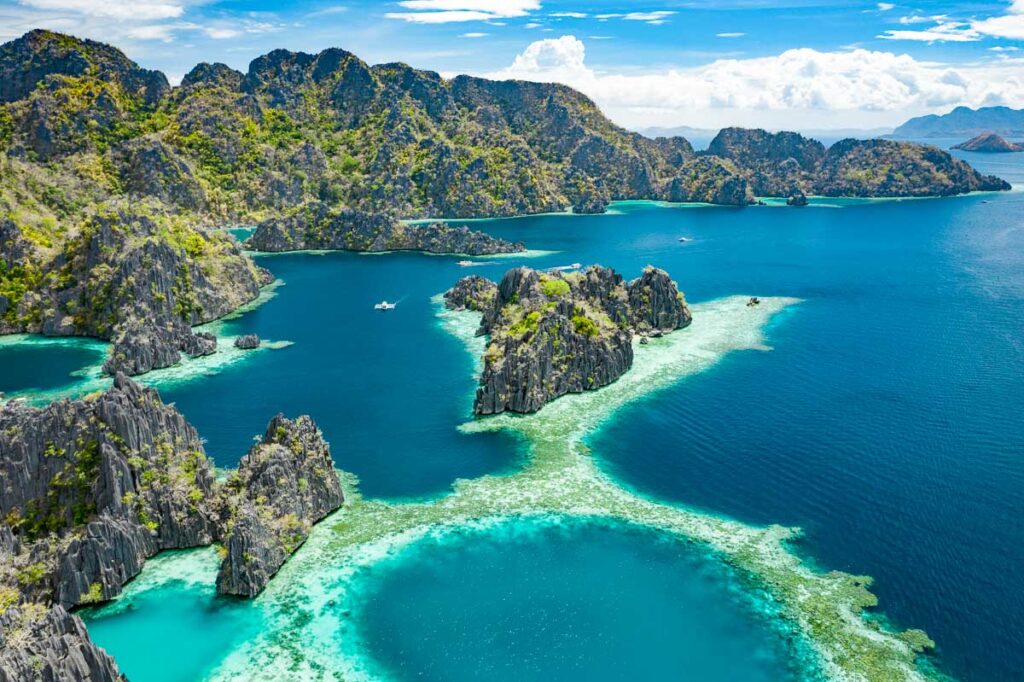
17. Palawan Island (Puerto Princessa & El Nido), Philippines
Did you know that Palawan Island was voted as the “Best Island in the World” by Travel + Leisure magazine not once, but twice? It’s no surprise why. Adventure awaits when you visit Palawan Island in the Philippines with its crystal clear waters, white sand beaches, and vibrant forests.
Located on the country’s western side, this island is home to some of Southeast Asia’s most breathtaking sights – from lush rainforests and spectacular beaches to crystal clear lagoons and soaring mountains.
In Puerto Princessa, boat through underground rivers and wildlife reserves or relax on one of the many amazing beaches. In El Nido, you can take island hopping tours, explore hidden lagoons, or go scuba diving to see vibrant coral reefs and marine life up close.
To visit Palawan Island, you can fly into either Puerto Princessa or El Nido. Taking a boat tour is a common way to see the best sights.
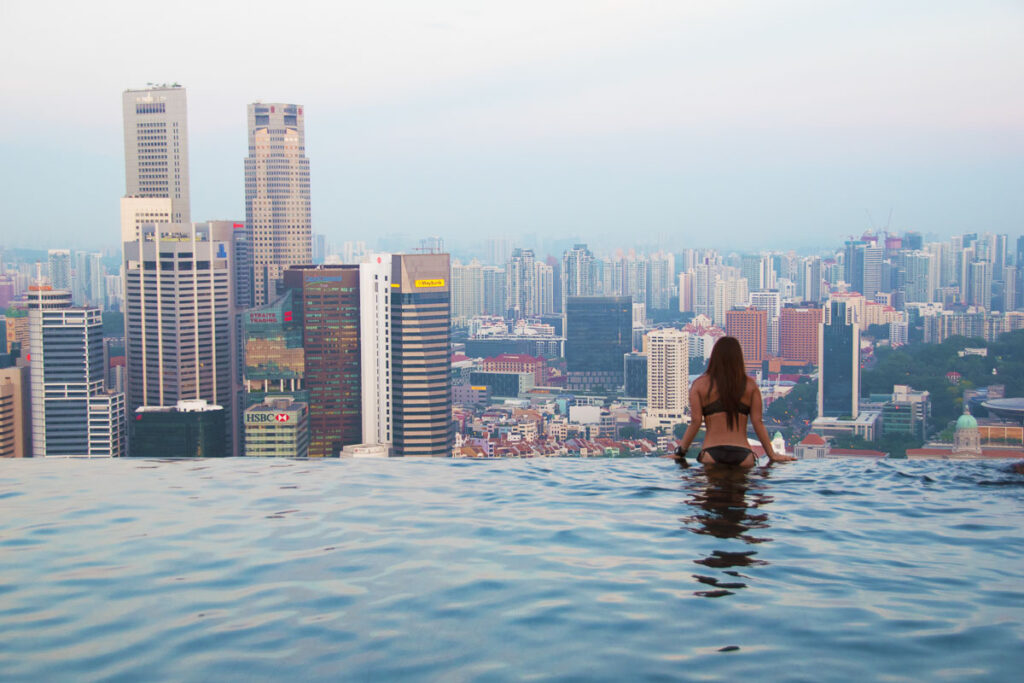
18. Marina Bay Sands, Singapore
We’ve all seen that iconic rooftop infinity pool overlooking Singapore’s skyline. Located in the city’s heart, Singapore wouldn’t be the same without this famous landmark hotel.
Marina Bay Sands opened in 2010 and quickly became one of Singapore’s most popular tourist destinations. In addition to its luxurious hotel, it boasts a massive shopping mall, a casino, and numerous restaurants serving up delicious cuisine from around the world.
What’s more, it’s right by another one of Singapore’s most famous attractions, Gardens by the Bay, a sprawling nature park that features gardens filled with exotic flora.
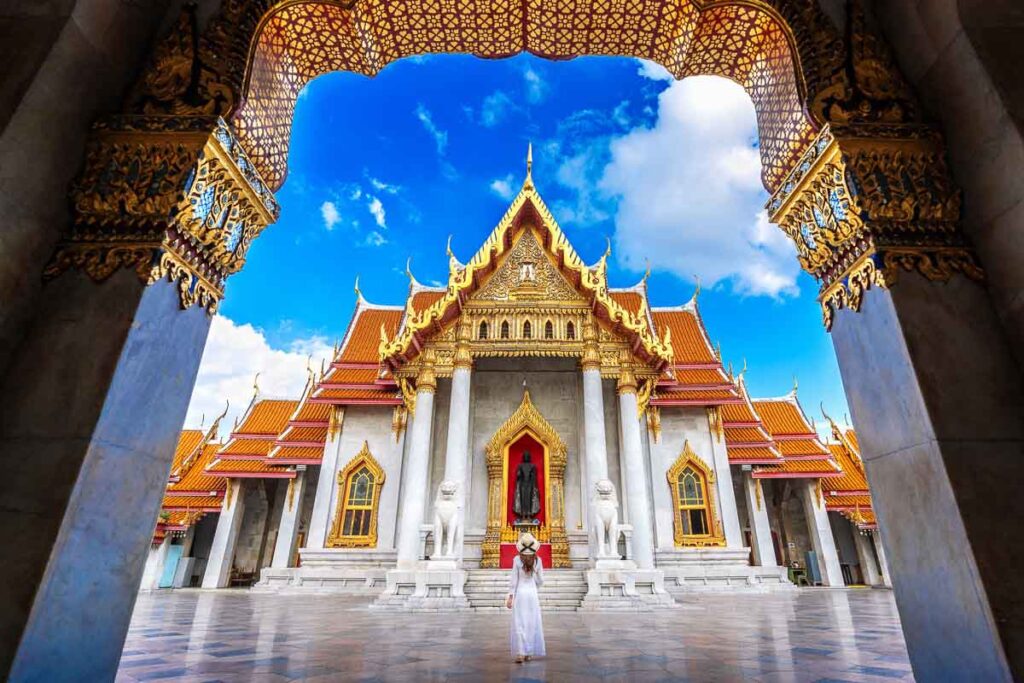
19. Grand Palace, Bangkok
In the center of Bangkok, the Grand Palace is a complex of buildings that showcase traditional Thai architecture at its finest. The palace grounds feature a sacred Buddhist temple, the royal court, and several exhibition halls. It was built in 1782 and served as home to generations of Thai kings until 1925, when it became an official royal museum.
Meander through the palace’s many halls, pavilions, and courtyards while admiring intricate details like gold leaf and colorful mosaics. One of the most famous attractions within the Grand Palace complex is Wat Phra Kaew – also known as the Temple of the Emerald Buddha. This temple houses a statue of Buddha carved from a single piece of jade.
To visit the Grand Palace, arrive early in the morning is best to avoid the crowds and Bangkok heat. Dress modestly – covering their shoulders and knees. A tour of the Grand Palace will take you back in time with its captivating architecture, sculptures, and paintings depicting Thailand’s history.
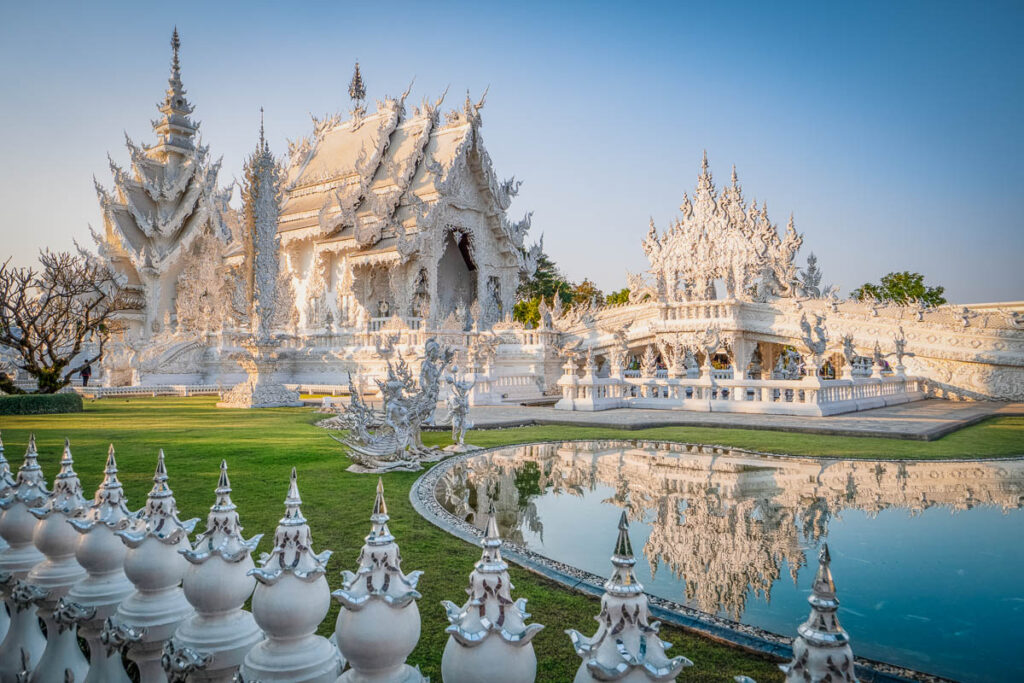
20. White Temple, Thailand
The moment your eyes meet the White Temple in Chiang Rai (Wat Rong Khun), you’ll be mesmerized by its captivating, modern architecture. In contrast to other classic Thai temples and pagodas, every inch of this temple gleams pure white and is ornamented with thousands of shimmering mirrors. Furthermore, unearthly pools featuring arms reaching up to the skies and striking pop culture illustrations complete what can only be described as a creative modern take on traditional Thai architecture.
Located in Chiang Rai province, White Temple was designed by Thai artist Chalermchai Kositpipat, who generously funded the entire temple renovation by investing an estimated THB 1,08 billion ($33 million USD) of his own money!
The temple was built as an offering to Buddha, where you can still see various statues and murals depicting Buddhist teachings. But really, its surreal design makes it an excellent spot for photography.
To visit the White Temple, many people start from Chiang Mai for a day trip tour. White Temple is 30 minutes south of Chiang Rai. Arrive an hour before closing to avoid the massive number of tour groups that come in the morning hours (or join them here). Since it is a temple, cover your shoulders and knees.
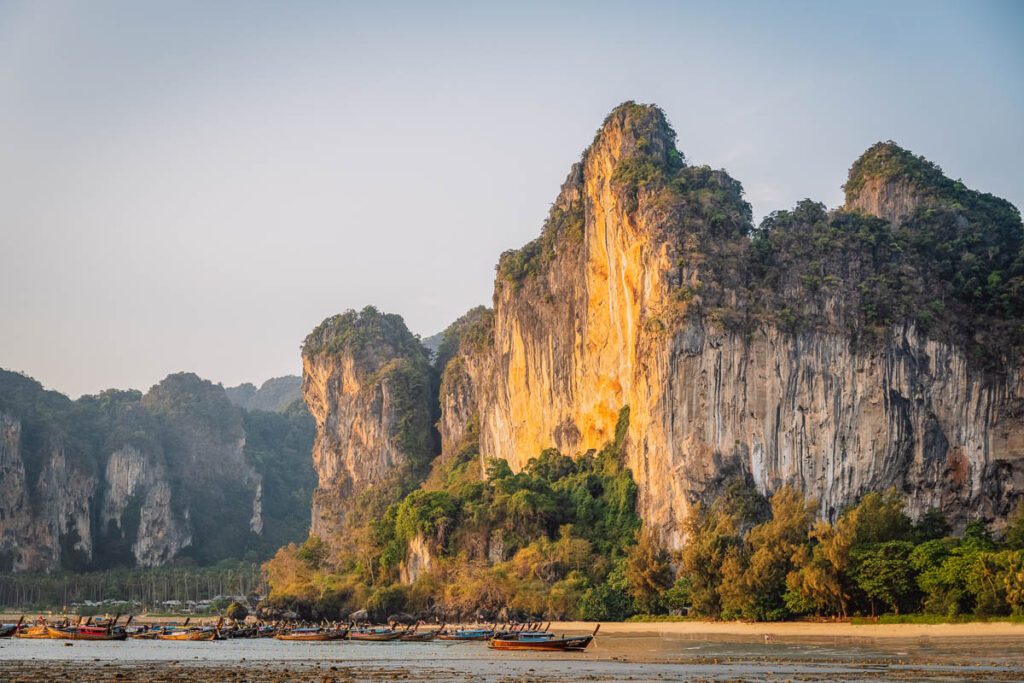
21. Railay Beach, Thailand
Railay Beach is an idyllic Southeast Asian paradise surrounded by limestone cliffs and crystal-clear waters in the Andaman sea.
The beach is divided into four main areas – West Railay, East Railay, Phra Nang Beach, and Tonsai Bay. West Railay and East Railay are both accessible only by longtail boat or on foot via a jungle trail, as they are surrounded by steep limestone walls blocking any roads.
Soak in the sun on the white sandy beaches, swim in the warm waters, or hike into the nearby caves and lagoons. For adventure seekers, Railay is one of Southeast Asia’s best spots for rock climbing. There are also opportunities for kayaking and snorkeling.
To visit Railay Beach, most people start in Bangkok or Phuket to get to Krabi Town or Ao Nang. Then take a longtail boat, which takes around 20-30 minutes and offers excellent coastline views.
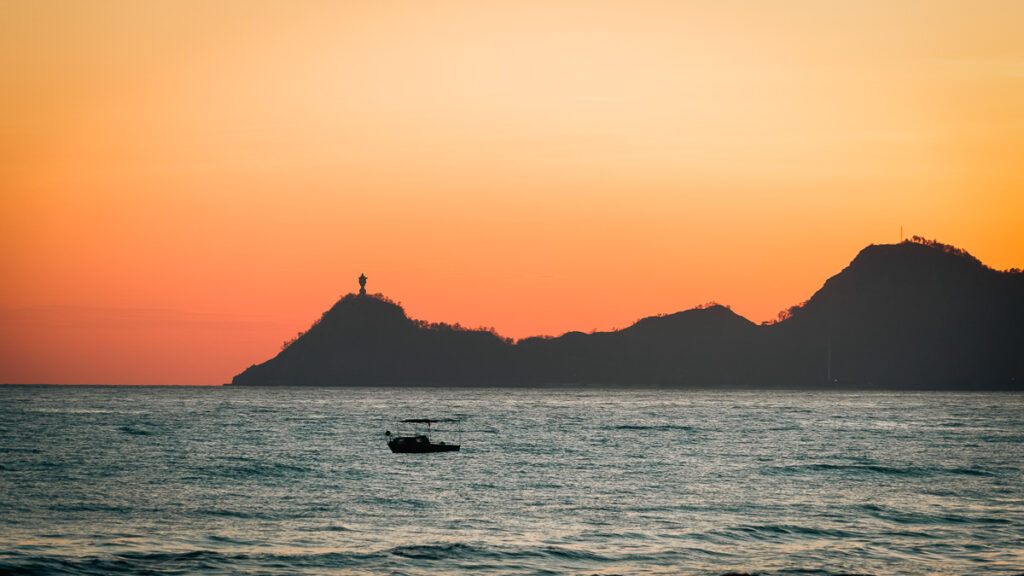
22. Cristo Rei, Timor-Leste
Cristo Rei is a tall religious statue located on a hill overlooking Dili Bay and is considered one of the tallest Jesus statues in Asia. Inspired by Rio de Janeiro’s famous Christ the Redeemer statue, this 28-meter tall monument was a gift as a symbol of peace and unity for the people of Timor-Leste, who gained independence from Indonesia in 2002.
Note: This isn’t the most exciting thing to do in Timor-Leste, for that, I would say Jaco Island is. With little transportation to get there, this remote place may very well be the most beautiful island I’ve ever been to.
To reach Cristo Rei, it’s a short taxi ride from Dili city center. Climb up a long flight of stairs to reach the panoramic views of Dili and the surrounding mountains.
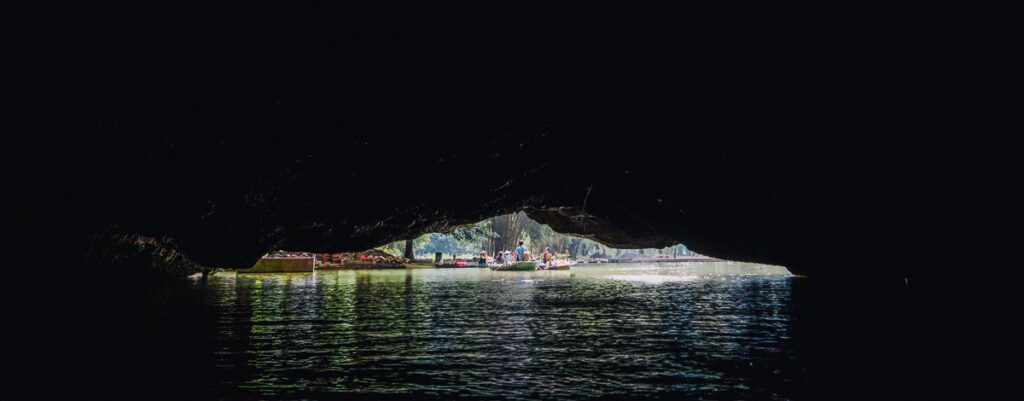
23. Han Son Doong, Vietnam
Vietnam’s Han Son Doong Cave is easily one of Southeast Asia’s most impressive natural landmarks as it’s the largest discovered cave in the world, only opened to tourism in 2009!
Situated in the Phong Nha-Ke Bang National Park, this massive cave boasts some of the world’s most enormous stalactites and stalagmites, and its interior is filled with hidden chambers and colorful rock formations. The huge underground space is so big that it could fit a 40-story skyscraper! In fact, it even has its own river running through it.
Embark on a once-in-a-lifetime adventure through Han Son Doong with experienced guides. The journey takes several days and includes trekking through dense jungle, crossing rivers, and camping inside the cave itself. Along the way, you will encounter stunning rock formations, underground lakes, and unique wildlife.
To visit Han Son Doong, you must book a tour through an Oxalis Adventure (the only operator). Only a limited number of visitors are allowed each year to preserve the cave’s delicate ecosystem. Unfortunately, this is booked out well in advance and costs 3,000+ USD!
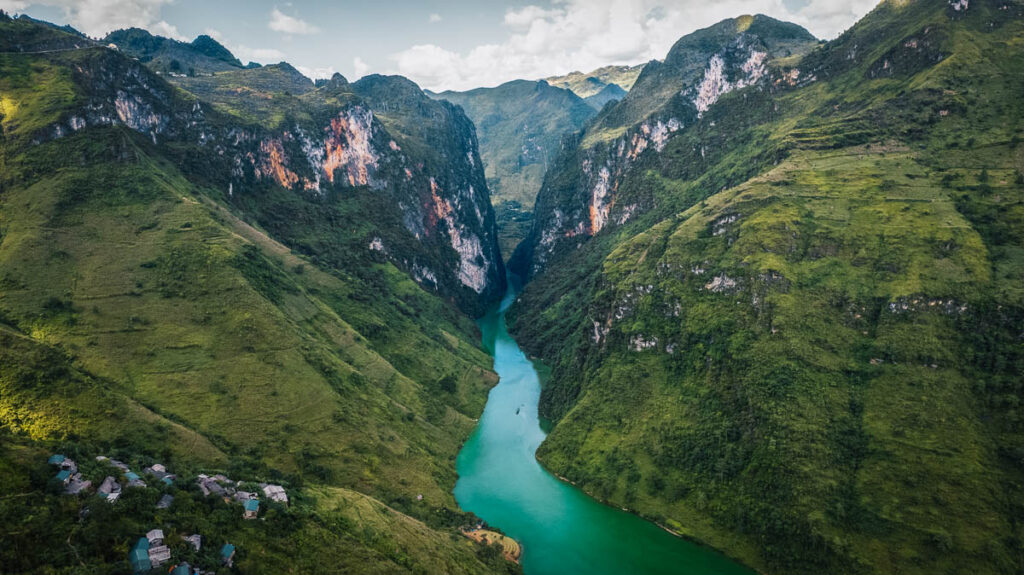
24. Ha Giang Loop, Vietnam
The beautiful Ha Giang Loop is hands down my favorite spot in Vietnam. More specifically, the Ma Pi Leng Pass took my breath away.
This incredibly scenic motorcycle route through northern Vietnam takes riders along some of the country’s most spectacular landscapes. The route passes through verdant green rice paddies, incredible Vietnam waterfalls, winding mountain roads, remote tribal villages, and staggering limestone outcroppings with crazy views at every turn.
The loop spans over 300 kilometers and usually takes 3-4 days to complete. Along the way, there are plenty of places to stop for food, rest, and sightseeing. It’s worth taking some time to discover the traditional villages where you can learn about local culture and visit local markets and homestays.
To start a tour of the Ha Giang Loop, take a bus to the city of Ha Giang. From there, they can rent a motorbike or hire a guide to take you around the loop.
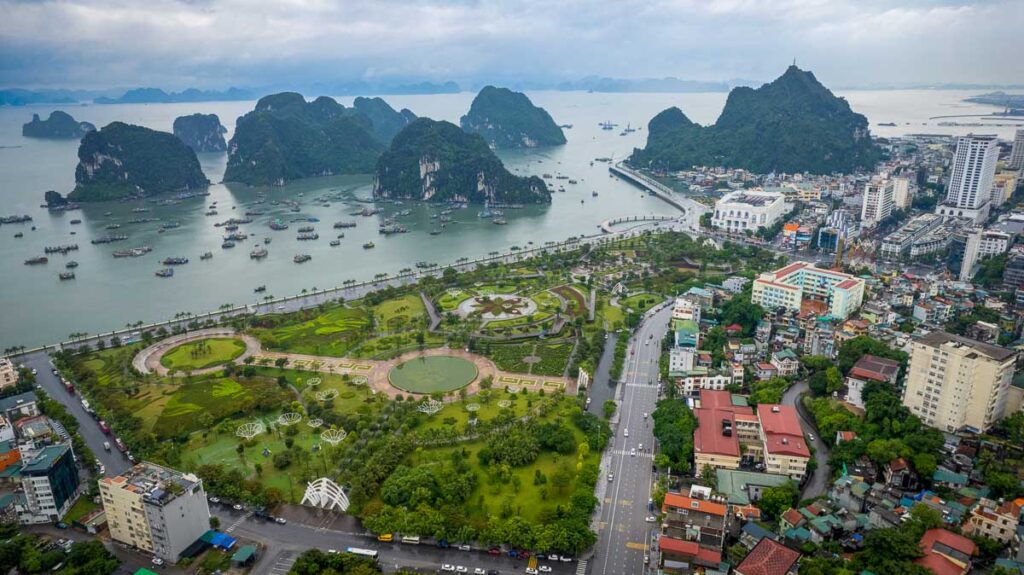
25. Ha Long Bay, Vietnam
Ha Long Bay is one of Southeast Asia’s most well-known sights; its beauty has been recognized by UNESCO as a World Heritage Site since 1994. Characterized by emerald waters, 1600+ limestone karsts, and green islets, this majestic bay offers landscapes that will leave you speechless.
According to legend, the bay was created by a giant dragon who thrashed its tail through the water, causing the islands to rise up out of the sea.
Explore Ha Long Bay by taking a cruise through the islands. Along the way, you’ll encounter jagged rock formations, hidden caves, and floating villages where locals still live and work. It’s also possible to join an overnight cruise for a more luxurious experience or stay overnight on Cat Ba Island.
To visit Ha Long Bay, fly into Hanoi and take a bus to Halong City. From there, you can book a boat tour with one of many agencies in the city.
Final Thoughts: Most Famous Landmarks in Southeast Asia
From the ancient temples of Myanmar to the eye-popping landscapes of Indonesia, each country in Southeast Asia has its own unique, splendid attractions. From majestic historical monuments to incredible natural wonders, there’s so much to do in this region of the world you can literally not finish them all.
Hopefully, this article honed the list a bit to a mere 25 famous Southeast Asia landmarks that should definitely be added to your bucket list! But I promise you, you’ll still want more.
| TRAVEL RESOURCES |
| ✈️ Find the best tours and activities with Viator to cross off your bucket list and create unforgettable memories 🏘️ Book your accommodation with Booking.com in advance and check availability on the days of your travels. 🧾 Rent a car in advance with Discovercars for those epic road trips at the best price. |
Catherine Xu is the founder and author of Nomadicated, an adventure travel blog that helps travelers cross off their bucket list. Since discovering traveling in 2015, she has lived and journeyed to 65 countries across 5 continents and vanlifed the west coast USA for 2+ years. These days, she splits her time in Southeast Asia and California while sharing her travel stories and resources based on first-hand experiences. Catherine's other works has been referenced in major publications like MSN, Self, and TripSavvy.

